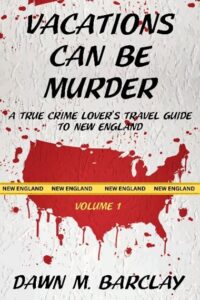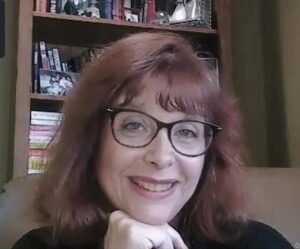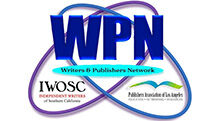 On March 25, 2025, Level Best Books released Vacations Can Be Murder: A True Crime Lover’s Travel Guide to New England. It’s the first of a multivolume true crime guidebook series covering the entire country. I’ve been asked to update the Writers and Publishers Network on exactly what went into creating this book and bringing it to market.
On March 25, 2025, Level Best Books released Vacations Can Be Murder: A True Crime Lover’s Travel Guide to New England. It’s the first of a multivolume true crime guidebook series covering the entire country. I’ve been asked to update the Writers and Publishers Network on exactly what went into creating this book and bringing it to market.
A little about me: Though my background is in nonfiction (corporate communications professional and a veteran travel journalist for travel trade publications), most authors know me for the psychological/domestic/romantic suspense books I’ve written for various publishers since 2016 as D. M. Barr. But nonfiction was really where I started, at least in magazine form, and COVID gave me the time to write a book I’d wanted to write since around 2004. After I signed with an agent, Rowman & Littlefield released that book in 2022, titled Traveling Different: Vacation Strategies for Parents of the Anxious, the Inflexible, and the Neurodiverse.
And that’s when good things started to happen. I’m delighted to say that it received a starred review from Library Journal and won the coveted Lowell Thomas Gold award from the Society of American Travel Writers Foundation. The audiobook rights went up on auction. I did over 100 podcast interviews and sold excerpts and articles about autism travel to many special needs publications as well as Costco Connection (circ. 15+ million). I even got mentioned in USA Today. This is a long way of saying that I figured out pretty quickly that if you want exposure and sales, nonfiction is a faster route. So needless to say, I kept my eyes open for more nonfiction ideas and opportunities.
Where did the idea come from? I know this is where everyone expects me to say I’m a true crime addict and virtually inhaled every book, podcast, and documentary I could find, but that just isn’t the case. I was at Bouchercon in 2022 and took a true crime tour of Minneapolis and St. Paul. It was pretty interesting, and I wondered if anyone had written a book listing all the true crime tours around the country. The idea of expanding that to include summaries of true crimes in each state, along with crime- and justice-related hotels and restaurants, came later (people have to have a place to stay and eat, right?). From there, the idea snowballed, and I included a list of additional books people could read to learn more about the crimes that I’d summarized; true crime- and justice-related museums and attractions; the prisons and jails where all the criminals had been incarcerated; the cemeteries where everyone mentioned was buried . . . and then I combined all those disparate elements into easy-to-follow itineraries covering different areas of each state. The last thing I added was a list of victim resources per state, to make the book truly helpful to anyone who had to deal with such horrors in today’s chaotic world.
How did I do my research? The point of the book is to give readers the exact addresses of where the crimes occurred so people could get as close to true crime as possible while still breathing. And that took some effort. Anyone who’s written historical fiction will be familiar with many of my resources. Newspapers.com and Ancestry.com were lifesavers. Sometimes, I had to plow through ten different newspapers before nailing down an address. Even so, to minimize gawking, I never included street numbers of private homes, but rather the block number (e.g., the 100 block of Main Street). There are apps to help you find gravesites and mapping software to simplify the creation of logical itineraries that don’t require backtracking. As always, Google is your friend, but so are historical libraries and societies, which helped me when I couldn’t find information that predated modern newspapers.
Surprisingly, AI was not my friend. I fact-checked everything on my own twice, and then for kicks, fed every paragraph into AI to see if I’d left anything out, or made any mistakes. AI found plenty of errors, but when I checked my resources again and then asked AI to leave out Wikipedia as a source and to show me the sources of any of the contradictory information it was offering, it couldn’t do it. It admitted it was wrong. I demanded an apology for wasting my time. (This is how I’m now sure I’m insane.) And I got more than one, but they didn’t change my view that you just can’t trust AI for accuracy. Or Wikipedia. So I didn’t.
Finally, because I’m a Realtor, I have access to apps that help me find addresses from decades back, and in some cases, I was able to conduct my own virtual detective work to find some locations not mentioned in newspapers or trial transcripts. That was the most fun I had while writing the books.
What was the process of bringing it to market? Any moral quandaries? I decided early on that I’d prefer to publish through a mystery publisher rather than a travel publisher because they’d already have the audience. Luckily, Shawn Reilly Simmons at Level Best Books had just launched a true crime imprint, Level Tru. So I really didn’t have to shop the idea around much, though I did present LBB with a full nonfiction proposal before they signed me on.
Interestingly, I originally and naively thought Vacations Can Be Murder would be one book. Then when I started writing it and adding sections on, I thought I could do it in three volumes: East Coast, West Coast, and Midwest. Massachusetts, and then all the Mid-Atlantic states, quickly disabused me of that notion. New York alone took up almost 30,000 words, and that excluded everything outside of the area between Albany and Long Island. I had to push DC, Maryland, and Delaware into a different volume, and I had to leave out crimes that didn’t involve multiple murders. Plus, if the crime didn’t have several places to visit, I left it out. (That’s why the Preppy Killer isn’t in the New York chapter; some area in Central Park was too vague a location to give.) Anyway, I’m now figuring on ten volumes, but I have a feeling that some states, like Florida and Texas, may warrant their own books. I’ll know when I get to them.
As for moral quandaries: occasionally, I did have an ethical doubt about pointing out where all the crimes occurred. But I’ve been reassured by numerous others that the information, including the EXACT addresses, is available online and in newspapers for anyone who’s interested enough to look. I’m just repackaging that information. Plus, adding the Victim Resources section helped appease my conscience.
What am I doing to promote the book? I’m doing the same thing I do with every book—I consider the hooks and brainstorm who might be interested in them. For this book, I’m contacting all the broadcast and print media in the six New England states, the tourist boards, the historical libraries and societies, the public libraries, the chambers of commerce, all of the locations mentioned in the book, in case they’d like to stock and resell it, gift shops, metaphysical shops (because of the paranormal inclusions), independent bookstores, and podcasters covering books, travel, true crime, and the paranormal. What really helped was listing all the cities and towns mentioned in the book, so I could target just those areas to start. I won’t lie—it’s an exhausting process. But when I heard what publicists wanted to charge for doing far less, I knew I could do a better job myself. Time will tell if I was correct.
In the meantime, please check out my website, or my Facebook for more information and purchase links. The book is available at all major online book distributors. Available on Amazon here. The Mid-Atlantic edition is due out in August.

Dawn M. Barclay is a veteran award-winning travel journalist who penned Traveling Different: Vacation Strategies for Parents of the Anxious, the Inflexible, and the Neurodiverse (Rowman & Littlefield, 2022), which won awards, including the Lowell Thomas Gold Award in 2023. She is the author of hundreds of trade and consumer articles. As D. M. Barr, she’s written six psychological, domestic, and romantic thrillers and has edited two anthologies, with a third coming later this year. Barclay is a member of Sisters in Crime, Mystery Writers of America, the Society of American Travel Writers, and the New York Travel Writers Association.
